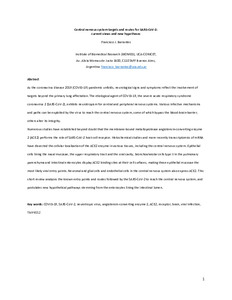Por favor, use este identificador para citar o enlazar este ítem:
https://repositorio.uca.edu.ar/handle/123456789/10846| Campo DC | Valor | Lengua/Idioma |
|---|---|---|
| dc.contributor.author | Barrantes, Francisco José | es |
| dc.date.accessioned | 2020-11-03T19:48:07Z | - |
| dc.date.available | 2020-11-03T19:48:07Z | - |
| dc.date.issued | 2020 | - |
| dc.identifier.citation | Barrantes FJ. Central nervous system targets and routes for SARS-CoV-2 : current views and new hypotheses [en línea]. ACS chemical neuroscience. 2020, 11(18). Disponible en: https://repositorio.uca.edu.ar/handle/123456789/10846 | es |
| dc.identifier.issn | 1948-7193 | - |
| dc.identifier.uri | https://repositorio.uca.edu.ar/handle/123456789/10846 | - |
| dc.description.abstract | Abstract: As the coronavirus disease 2019 (COVID-19) pandemic unfolds, neurological signs and symptoms reflect the involvement of targets beyond the primary lung affectation. The etiological agent of COVID-19, the severe acute respiratory syndrome coronavirus 2 (SARS-CoV-2), exhibits neurotropism for central and peripheral nervous systems. Various infective mechanisms and paths can be exploited by the virus to reach the central nervous system, some of which bypass the blood-brain-barrier; others alter its integrity. Numerous studies have established beyond doubt that the membrane-bound metalloprotease angiotensin-converting enzyme 2 (ACE2) performs the role of SARS-CoV-2 host-cell receptor. Histochemical studies and more recently transcriptomics of mRNA have dissected the cellular localization of the ACE2 enzyme in various tissues, including the central nervous system. Epithelial cells lining the nasal mucosae, the upper respiratory tract and the oral cavity, bronchoalveolar cells type II in the pulmonary parenchyma and intestinal enterocytes display ACE2 binding sites at their cell surfaces, making these epithelial mucosae the most likely viral entry points. Neuronal and glial cells and endothelial cells in the central nervous system also express ACE2. This short review analyzes the known entry points and routes followed by the SARS-CoV-2 to reach the central nervous system, and postulates new hypothetical pathways stemming from the enterocytes lining the intestinal lumen. | es |
| dc.format | application/pdf | es |
| dc.language.iso | eng | es |
| dc.publisher | American Chemical Society | es |
| dc.rights | Acceso abierto | * |
| dc.rights.uri | http://creativecommons.org/licenses/by-nc-sa/4.0/ | * |
| dc.subject | MEDICINA | es |
| dc.subject | COVID-19 | es |
| dc.subject | SARS-CoV-2 | es |
| dc.subject | PANDEMIA | es |
| dc.subject | INFECCIONES | es |
| dc.subject | VIRUS | es |
| dc.title | Central nervous system targets and routes for SARS-CoV-2 : current views and new hypotheses | es |
| dc.type | Artículo | es |
| dc.identifier.doi | 10.1021/acschemneuro.0c00434 | - |
| uca.disciplina | MEDICINA | es |
| uca.issnrd | 1 | es |
| uca.affiliation | Fil: Barrantes, Francisco José. Pontificia Universidad Católica Argentina. Facultad de Ciencias Médicas. Instituto de Investigaciones Biomédicas. Laboratorio de Neurobiología Molecular; Argentina | es |
| uca.affiliation | Fil: Barrantes, Francisco José. Consejo Nacional de Investigaciones Científicas y Técnicas; Argentina | es |
| uca.version | publishedVersion | es |
| item.fulltext | With Fulltext | - |
| item.grantfulltext | open | - |
| item.languageiso639-1 | en | - |
| crisitem.author.dept | Instituto de Investigaciones Biomédicas - BIOMED | - |
| crisitem.author.dept | Laboratorio de Neurobiología Molecular | - |
| crisitem.author.dept | Facultad de Ciencias Médicas | - |
| crisitem.author.orcid | 0000-0002-4745-681X | - |
| crisitem.author.parentorg | Facultad de Ciencias Médicas | - |
| crisitem.author.parentorg | Instituto de Investigaciones Biomédicas - BIOMED | - |
| crisitem.author.parentorg | Pontificia Universidad Católica Argentina | - |
| Aparece en las colecciones: | Artículos | |
Ficheros en este ítem:
| Fichero | Descripción | Tamaño | Formato | |
|---|---|---|---|---|
| central-nervous-system-targets.pdf | 1,12 MB | Adobe PDF |  Visualizar/Abrir |
Visualizaciones de página(s)
111
comprobado en 30-abr-2024
Descarga(s)
296
comprobado en 30-abr-2024
Google ScholarTM
Ver en Google Scholar
Altmetric
Altmetric
Este ítem está sujeto a una Licencia Creative Commons

